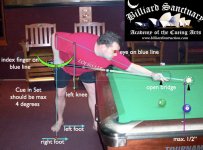Pool is the only game you will ever see anyone in stance bent over at the waist. In every other sport i can think of when you have to get low you bend a leg/legs, all the motions we learn b/c thats usually what is better mechanically and like i said you just don't see anyone bending half over doing anything else, so what makes pool players believe that doing so continuously for long periods of time could be anything but good for our physiology.
I'm 5'7 and I had back/neck/shoulder pain while I was shooting back in college. I was bending at the waist, I had my bridge arm fully extended, and I got low on the ball.
I actually hyper-extended

my elbow playing for over 12hrs like that. Good thing I was on the distance team so I was able to go to our trainers and get some rehab/ultrasound etc for it. BUT man did i get ragged! Jokes about how they didn't know pool was a contact sport lol.
Anyways ever since then I have ran into a few diff people that had similar problems and I worked with them on it and they had fantastic results....one of the guys was a very tall fella up in tulsa that worked up at the palace (forget his name) I remember how receptive he was about the idea and how much of a diff it made for him.
Just one of those things I've happened to experience and troubleshoot in a handful of players I've worked with, starting with myself.
That was the first major change to my game that I ever went through....
Its like anything else. You can throw a ball fast but if you don't do it right your going to hurt yourself. Being that we are in such a stoic position while we are playing and in stance you can create ALOT of pressure on your bodys muscles/ joints/ligaments....and you can hurt your self....just like diamonds it takes time and pressure and then POP your elbow/back/neck etc...just aint right anymore.
-Greyghost-

